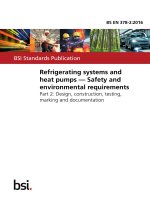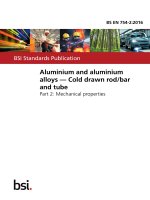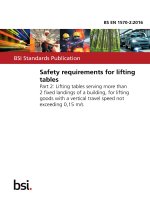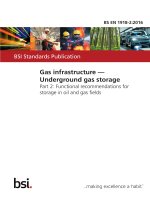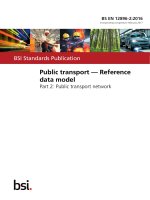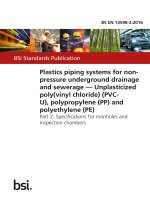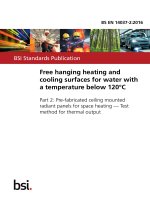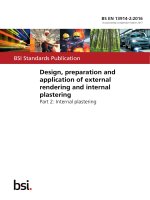Bsi bs en 00599 2 2016
Bạn đang xem bản rút gọn của tài liệu. Xem và tải ngay bản đầy đủ của tài liệu tại đây (1.7 MB, 14 trang )
BS EN 599-2:2016
BSI Standards Publication
Durability of wood and woodbased products — Efficacy of
preventive wood preservatives
as determined by biological
tests
Part 2: Labelling
BS EN 599-2:2016
BRITISH STANDARD
National foreword
This British Standard is the UK implementation of EN 599-2:2016. It
supersedes BS EN 599-2:1997 which is withdrawn.
The UK participation in its preparation was entrusted to Technical
Committee B/515, Wood preservation.
A list of organizations represented on this committee can be
obtained on request to its secretary.
This publication does not purport to include all the necessary
provisions of a contract. Users are responsible for its correct
application.
© The British Standards Institution 2016.
Published by BSI Standards Limited 2016
ISBN 978 0 580 88433 7
ICS 71.100.50
Compliance with a British Standard cannot confer immunity from
legal obligations.
This British Standard was published under the authority of the
Standards Policy and Strategy Committee on 31 October 2016.
Amendments/Corrigenda issued since publication
Date
Text affected
BS EN 599-2:2016
EN 599-2
EUROPEAN STANDARD
NORME EUROPÉENNE
EUROPÄISCHE NORM
October 2016
ICS 71.100.50
Supersedes EN 599-2:1995
English Version
Durability of wood and wood-based products - Efficacy of
preventive wood preservatives as determined by
biological tests - Part 2: Labelling
Durabilité du bois et des matériaux dérivés du bois Efficacité des produits préventifs de préservation du
bois établie par des essais biologiques - Partie 2 :
Étiquetage
Dauerhaftigkeit von Holz und Holzprodukten Anforderungen an Holzschutzmittel wie sie durch
biologische Prüfungen ermittelt werden - Teil 2:
Kennzeichnung
This European Standard was approved by CEN on 15 July 2016.
CEN members are bound to comply with the CEN/CENELEC Internal Regulations which stipulate the conditions for giving this
European Standard the status of a national standard without any alteration. Up-to-date lists and bibliographical references
concerning such national standards may be obtained on application to the CEN-CENELEC Management Centre or to any CEN
member.
This European Standard exists in three official versions (English, French, German). A version in any other language made by
translation under the responsibility of a CEN member into its own language and notified to the CEN-CENELEC Management
Centre has the same status as the official versions.
CEN members are the national standards bodies of Austria, Belgium, Bulgaria, Croatia, Cyprus, Czech Republic, Denmark, Estonia,
Finland, Former Yugoslav Republic of Macedonia, France, Germany, Greece, Hungary, Iceland, Ireland, Italy, Latvia, Lithuania,
Luxembourg, Malta, Netherlands, Norway, Poland, Portugal, Romania, Slovakia, Slovenia, Spain, Sweden, Switzerland, Turkey and
United Kingdom.
EUROPEAN COMMITTEE FOR STANDARDIZATION
COMITÉ EUROPÉEN DE NORMALISATION
EUROPÄISCHES KOMITEE FÜR NORMUNG
CEN-CENELEC Management Centre: Avenue Marnix 17, B-1000 Brussels
© 2016 CEN
All rights of exploitation in any form and by any means reserved
worldwide for CEN national Members.
Ref. No. EN 599-2:2016 E
BS EN 599-2:2016
EN 599-2:2016 (E)
Contents
Page
European foreword....................................................................................................................................................... 3
Introduction .................................................................................................................................................................... 4
1
Scope .................................................................................................................................................................... 5
2
Normative references .................................................................................................................................... 5
3
Terms and definitions ................................................................................................................................... 5
4
Labelling ............................................................................................................................................................. 5
5
5.1
5.2
5.3
5.4
5.4.1
5.4.2
5.4.3
5.5
5.6
5.7
Labelling requirements ................................................................................................................................ 6
General ................................................................................................................................................................ 6
Product name ................................................................................................................................................... 6
Use class appropriate for the product ..................................................................................................... 6
Application process ........................................................................................................................................ 6
General ................................................................................................................................................................ 6
Superficial application .................................................................................................................................. 6
Penetrating application ................................................................................................................................ 6
Type of wood ..................................................................................................................................................... 6
Target organisms ............................................................................................................................................ 6
Application rate ............................................................................................................................................... 7
Annex A (informative) Example of how to report efficacy information on a label ............................... 8
Bibliography .................................................................................................................................................................... 9
2
BS EN 599-2:2016
EN 599-2:2016 (E)
European foreword
This document (EN 599-2:2016) has been prepared by Technical Committee CEN/TC 38 “Durability of
wood and wood-based products”, the secretariat of which is held by AFNOR.
This European Standard shall be given the status of a national standard, either by publication of an
identical text or by endorsement, at the latest by March 2017, and conflicting national standards shall
be withdrawn at the latest by March 2017.
Attention is drawn to the possibility that some of the elements of this document may be the subject of
patent rights. CEN shall not be held responsible for identifying any or all such patent rights.
This document supersedes EN 599-2:1995.
Significant technical differences between this edition and EN 599-2:1995 are as follows:
— Clause 4, Classification, Clause 5, Information to be supplied by the manufacturer and Clause 6,
Marking, have been merged into one Clause 4, Labelling, which outlines the information to be presented
on the product label, relative to its efficacy;
— an example of how to report efficacy information on a label is given in Annex A;
— the system of codes for use in classifying and labelling the efficacy of wood preservative products
has been abandoned;
— the Normative references and Bibliography have been updated.
According to the CEN-CENELEC Internal Regulations, the national standards organisations of the
following countries are bound to implement this European Standard: Austria, Belgium, Bulgaria,
Croatia, Cyprus, Czech Republic, Denmark, Estonia, Finland, Former Yugoslav Republic of Macedonia,
France, Germany, Greece, Hungary, Iceland, Ireland, Italy, Latvia, Lithuania, Luxembourg, Malta,
Netherlands, Norway, Poland, Portugal, Romania, Slovakia, Slovenia, Spain, Sweden, Switzerland,
Turkey and the United Kingdom.
3
BS EN 599-2:2016
EN 599-2:2016 (E)
Introduction
This part of EN 599 is one of a series and should be used in conjunction with EN 599-1, with EN 335,
which describes the use classes of treated wood, and with EN 351-1, which describes a classification
system for preservative treated wood in terms of preservative penetration and gives guidance on
retention requirements. The need for wood preservatives depends in part on the natural durability of
the wood and therefore this part of EN 599 should be used also in conjunction with EN 350 and EN 460.
This document only takes into account those aspects of the product labelling relating to wood
preservative efficacy. Additional items which are not mentioned in this standard should be listed on the
label where required by law.
4
BS EN 599-2:2016
EN 599-2:2016 (E)
1 Scope
This European Standard specifies the requirements for labelling wood preservative products according
to their efficacy and suitability for use, for each of the five use classes defined in EN 335.
This European Standard is applicable to all wood preservative products supplied for application in
liquid form for the preventive treatment of timbers (structural and non-structural) against woodattacking fungi, wood-attacking insects and marine organisms as described in EN 1001-2 and EN 335. It
is applicable to products for preventive treatments against fungi causing disfigurement (blue stain) of
wood in service, only if this forms part of the overall preventive effectiveness of the product.
This European Standard is not applicable to wood preservative products supplied for application as
pastes, solids or in capsule form because they cannot be tested without modification of the biological
tests demanded in this standard. It does not apply either to wood preservative products for remedial
(curative) treatments or to those applied to prevent fungi causing sap stain on green (unseasoned)
timber.
2 Normative references
The following documents, in whole or in part, are normatively referenced in this document and are
indispensable for its application. For dated references, only the edition cited applies. For undated
references, the latest edition of the referenced document (including any amendments) applies.
EN 335, Durability of wood and wood-based products - Use classes: definitions, application to solid wood
and wood-based products
EN 351-1, Durability of wood and wood-based products - Preservative-treated solid wood - Part 1:
Classification of preservative penetration and retention
EN 599-1:2009+A1:2013, Durability of wood and wood-based products - Efficacy of preventive wood
preservatives as determined by biological tests - Part 1: Specification according to use class
EN 1001-2:2005, Durability of wood and wood based products - Terminology - Part 2: Vocabulary
3 Terms and definitions
For the purposes of this document, the terms and definitions given in EN 1001-2:2005 and
EN 599-1:2009+A1:2013 apply.
4 Labelling
Wood preservative products shall be labelled according to their efficacy where tested in accordance
with EN 599-1.
The label shall include the following information:
— the name of the product;
— the use class(es) for which the wood preservative product is intended;
— the suitable application process(es);
— the type(s) of wood for which the product is suitable;
— the target organisms;
5
BS EN 599-2:2016
EN 599-2:2016 (E)
— the application rates/retentions.
NOTE 1
NOTE 2
An example of how this information may be presented on a label is given in Annex A.
Additional information may be required by European or national regulations.
5 Labelling requirements
5.1 General
The container of the product shall be labelled with or accompanied by the information specified in 5.2
to 5.7.
5.2 Product name
This is the trade name of the product.
5.3 Use class appropriate for the product
The label shall indicate the use class, according to EN 335, appropriate for the intended end use, when
complying with efficacy testing in accordance with EN 599-1. Products appropriate for use in more than
one use class shall be labelled with the number of each use class to which they conform.
NOTE
Additional information on the specific end uses can be given (e.g. poles, decking, windows).
In use class 3, where the product is to be used protected from direct wetting under a paint or other
coating, which is applied before the treated wood is put into use, this shall be stated.
5.4 Application process
5.4.1 General
The wood preservative product shall be defined as being suitable for either superficial application
processes, or penetrating treatment processes, or both types of process, providing that the
specifications given in EN 599-1 are complied with.
NOTE
Wood preservative products are formulated to suit a range of specific methods of application from
simple superficial processes to more technically complex, industrialized processes. The effectiveness of a product
can depend critically on the way it is applied (see EN 599–1:2009+A1:2013, Annex C).
One or more of the following application methods for which the product is designed shall be listed.
5.4.2 Superficial application
These include: brush, spray, dipping, other (to be specified).
5.4.3 Penetrating application
These include: vacuum/pressure, double vacuum, other (to be specified).
5.5 Type of wood
The wood preservative product shall be labelled to indicate its suitability for softwoods, for hardwoods
or for both.
5.6 Target organisms
The wood preservative product shall be labelled to indicate the organisms against which it has been
effectively tested in accordance with EN 599-1.
6
BS EN 599-2:2016
EN 599-2:2016 (E)
These could be one or more of the following: fungi (brown and white rot fungi), soft rot fungi, blue stain
in service, Hylotrupes bajulus, Lyctus brunneus, Anobium punctatum, termites and marine organisms.
Efficacy against all beetles may be claimed if efficacy has been shown against the most resistant of those
listed above.
5.7 Application rate
The required application rate shall be calculated in accordance with EN 351-1 from the critical value,
which is derived from EN 599-1 for the relevant use class and application process.
For superficially applied preservatives, this shall be expressed in grams per square metre.
For penetrating preservatives, this shall be expressed as the retention in kilograms per cubic metre in
the analytical zone in accordance with EN 351-1.
NOTE 1
An adjustment factor is applied to take account of local variations in building practices and climate as
well as of the variety of exposure conditions and service life requirements within a use class, as specified in
EN 351–1. This may lead to application rates being expressed as a range for a given use class.
NOTE 2
Certain physical and chemical properties of the wood preservative product can affect its efficacy. The
user is advised to seek further information, which may be relevant for a specific use, in the Technical Data Sheet
provided by the manufacturer.
7
BS EN 599-2:2016
EN 599-2:2016 (E)
Annex A
(informative)
Example of how to report efficacy information on a label
Name of the product
xxxx
Application process
Superficial (brush, dipping)
Use class
Type of wood
Target organism
Application rate
8
UC2; UC3
Hardwood, softwood
Fungi, beetles
UC2 120 g/m2
UC3 200 g/m2
BS EN 599-2:2016
EN 599-2:2016 (E)
Bibliography
[1]
[2]
EN 350, Durability of wood and wood-based products - Natural durability of solid wood
EN 460, Durability of wood and wood-based products - Natural durability of solid wood - Guide to
the durability requirements for wood to be used in hazard classes
9
This page deliberately left blank
This page deliberately left blank
NO COPYING WITHOUT BSI PERMISSION EXCEPT AS PERMITTED BY COPYRIGHT LAW
British Standards Institution (BSI)
BSI is the national body responsible for preparing British Standards and other
standards-related publications, information and services.
BSI is incorporated by Royal Charter. British Standards and other standardization
products are published by BSI Standards Limited.
About us
Reproducing extracts
We bring together business, industry, government, consumers, innovators
and others to shape their combined experience and expertise into standards
-based solutions.
For permission to reproduce content from BSI publications contact the BSI
Copyright & Licensing team.
The knowledge embodied in our standards has been carefully assembled in
a dependable format and refined through our open consultation process.
Organizations of all sizes and across all sectors choose standards to help
them achieve their goals.
Information on standards
We can provide you with the knowledge that your organization needs
to succeed. Find out more about British Standards by visiting our website at
bsigroup.com/standards or contacting our Customer Services team or
Knowledge Centre.
Buying standards
You can buy and download PDF versions of BSI publications, including British
and adopted European and international standards, through our website at
bsigroup.com/shop, where hard copies can also be purchased.
If you need international and foreign standards from other Standards Development
Organizations, hard copies can be ordered from our Customer Services team.
Copyright in BSI publications
All the content in BSI publications, including British Standards, is the property
of and copyrighted by BSI or some person or entity that owns copyright in the
information used (such as the international standardization bodies) and has
formally licensed such information to BSI for commercial publication and use.
Save for the provisions below, you may not transfer, share or disseminate any
portion of the standard to any other person. You may not adapt, distribute,
commercially exploit, or publicly display the standard or any portion thereof in any
manner whatsoever without BSI’s prior written consent.
Storing and using standards
Standards purchased in soft copy format:
• A British Standard purchased in soft copy format is licensed to a sole named
user for personal or internal company use only.
• The standard may be stored on more than 1 device provided that it is accessible
by the sole named user only and that only 1 copy is accessed at any one time.
• A single paper copy may be printed for personal or internal company use only.
Standards purchased in hard copy format:
• A British Standard purchased in hard copy format is for personal or internal
company use only.
• It may not be further reproduced – in any format – to create an additional copy.
This includes scanning of the document.
If you need more than 1 copy of the document, or if you wish to share the
document on an internal network, you can save money by choosing a subscription
product (see ‘Subscriptions’).
Subscriptions
Our range of subscription services are designed to make using standards
easier for you. For further information on our subscription products go to
bsigroup.com/subscriptions.
With British Standards Online (BSOL) you’ll have instant access to over 55,000
British and adopted European and international standards from your desktop.
It’s available 24/7 and is refreshed daily so you’ll always be up to date.
You can keep in touch with standards developments and receive substantial
discounts on the purchase price of standards, both in single copy and subscription
format, by becoming a BSI Subscribing Member.
PLUS is an updating service exclusive to BSI Subscribing Members. You will
automatically receive the latest hard copy of your standards when they’re
revised or replaced.
To find out more about becoming a BSI Subscribing Member and the benefits
of membership, please visit bsigroup.com/shop.
With a Multi-User Network Licence (MUNL) you are able to host standards
publications on your intranet. Licences can cover as few or as many users as you
wish. With updates supplied as soon as they’re available, you can be sure your
documentation is current. For further information, email
Revisions
Our British Standards and other publications are updated by amendment or revision.
We continually improve the quality of our products and services to benefit your
business. If you find an inaccuracy or ambiguity within a British Standard or other
BSI publication please inform the Knowledge Centre.
Useful Contacts
Customer Services
Tel: +44 345 086 9001
Email (orders):
Email (enquiries):
Subscriptions
Tel: +44 345 086 9001
Email:
Knowledge Centre
Tel: +44 20 8996 7004
Email:
Copyright & Licensing
Tel: +44 20 8996 7070
Email:
BSI Group Headquarters
389 Chiswick High Road London W4 4AL UK

